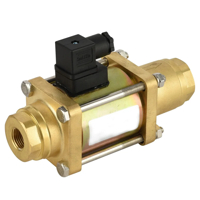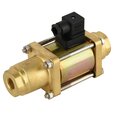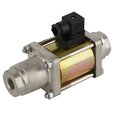How Fluid Viscosity Affects Solenoid Valve Performance

Figure 1: Coaxial solenoid valve suitable for highly viscous fluids
Viscosity affects several process parameters within industrial systems. Understanding how fluid viscosity influences these parameters is essential for optimizing system performance and ensuring equipment longevity. This article explores the role of fluid viscosity in a solenoid valve's media flow profiles and tips for handling viscous media.
Why determine fluid viscosity
Viscosity is a measure of a fluid's internal resistance to flow. It affects several aspects of valve performance, such as pressure drop, valve response to actuator inputs, wear rates, and pump efficiency. The effect of viscosity on various process parameters in a solenoid valve is discussed below:
-
Reynolds number: Viscosity determines the flow regime, whether laminar or turbulent. The Reynolds number (a parameter describing the flow regime) relies on fluid viscosity for calculation, influencing the performance characteristics of solenoid valves.
- As the viscosity of the service fluid increases, the Reynolds number decreases, and vice versa.
- Fluids with low viscosity flow smoothly through valves, causing minimal erosion effects and cavitation. Alternatively, highly viscous fluids are slow-moving, have lower mechanical efficiencies, and lead to increased erosion within piping systems (gradual removal of material from the pipe walls, fittings, valves, and other components).
- Pressure drop: Viscosity affects the pressure drop inside the solenoid valve's body. Highly viscous fluids traveling at high speeds result in increased pressure drops. To maintain good frictional resistance and control the pressure drop, it is necessary to consider fluid viscosity when determining the correct valve sizes, construction materials, and trim styles. Highly viscous fluids often require specially-designed control valves different from those used for low-viscosity fluids (discussed later).
- Temperature and viscosity changes: As temperatures increase, the viscosity of liquids decreases rapidly. Determining viscosity values over the operating temperature range is crucial to precisely tuning solenoid valves. The viscosity index helps estimate fluid characteristics at different temperatures. Solenoid valves used for fluids with varying viscosity due to temperature fluctuations must provide adequate sealing and consistent performance characteristics.
Solenoid valves and viscous fluids
Standard solenoid valves can handle fluids with viscosities up to 40 or 50 CST (Centistoke), including air, light oils, and water. Beyond this range, there can be issues in the operation of solenoid valves due to their thin, flexible diaphragms with pilot holes, which can quickly become blocked. Consider the following design factors while selecting a solenoid valve for viscous media.
- Materials: The solenoid valve material should withstand the strain of high-viscosity media. These materials should also resist corrosion, especially if the media is acidic or contains other corrosive substances. Depending on the specific application and type of fluid, these materials might include hardened steel, brass, or high-grade plastics. Read our chemical compatibility chart for more information on the compatibility of different materials with various media.
- Valve type:Direct-acting solenoid valves are often preferred for highly viscous fluids because they do not require a pressure differential to operate. This is unlike pilot-operated valves that might struggle with viscous fluids due to the pressure requirements.
- Orifice size: The solenoid valve's orifice should be large enough to allow the viscous fluid to flow freely.
- Coil power: The solenoid valve coil should have sufficient power to move the viscous fluid.
- Seals: The solenoid valve seals should be designed to withstand the wear caused by the viscous fluid. They should be made of materials like PTFE and NBR that can resist the specific fluid being used and the increased wear caused by its viscosity.
- Valve operation: A normally closed solenoid valve is more suitable for high-viscosity applications as it remains closed when not energized, preventing the viscous fluid from causing unnecessary wear when it is not in use.
- Proper Installation: Proper installation impacts the performance and longevity of solenoid valves in high-viscosity applications. Install the valve in a manner that allows for easy access for maintenance and inspection. Additionally, ensure to reduce stress on the valve components, such as by avoiding sharp bends in the piping immediately before or after the valve.
Coaxial solenoid valves
Coaxial solenoid valves (Figure 1) are specially engineered to handle viscous and contaminated media, even under high pressures or temperatures. The inlet and outlet ports are directly opposite, creating an almost linear flow path. The unique design of coaxial valves makes them ideal for overcoming the challenges presented by viscous media. Coaxial solenoid valves are perfect for:
- Applications requiring high flow rates and small pressure loss
- Highly viscous media (more than 50 CST)
- Abrasive, aggressive, or slightly contaminated fluid
- Very high back pressure (up to 400 bars) or pressure fluctuations
- Quick response time
- Vacuum up to 10-4 mbar
- A system with zero pressure differential
Other considerations
- Viscosity range: Determine the viscosity range of the fluid and ensure that the solenoid valve is suitable for that range. Consult the valve manufacturer's specifications and guidelines.
- Response time: Consider the desired response time for the application. Note that higher-viscosity fluids may require longer response times.
- Power consumption: Higher viscosity fluids may require more power to actuate the solenoid valve. Consider the available power supply and ensure it is sufficient for proper valve operation.
FAQs
What are the differences in solenoid valve behavior when handling low versus high-viscosity fluids?
Low-viscosity fluids enable faster response and lower power usage in solenoid valves, while high-viscosity fluids cause slower response and higher power consumption.
How can I determine the ideal solenoid valve for my application considering fluid viscosity?
When selecting a solenoid valve, consider factors such as fluid viscosity, flow rate, operating pressure, and temperature to choose a valve that meets your specific application requirements.







